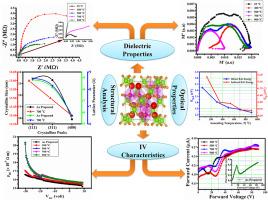znfe1la1004尖晶石铁氧体的制备及其介电、电学和光学研究
IF 2.4
4区 物理与天体物理
Q3 PHYSICS, CONDENSED MATTER
引用次数: 0
摘要
我们报道了通过溶胶-凝胶自燃烧合成La3+掺杂锌铁氧体,然后逐步退火到900°C 2小时。由于奥斯特瓦尔德成熟过程,观察到平均晶粒尺寸从12.2 nm增长到13.5 nm。最突出峰(311)的点阵参数从8.1855增加到8.2179 Å,符合Vegard定律。该材料具有较高的比表面积和介电常数实部,外加较低的介电常数虚部和介电正切损耗,在节能特别是高频超级电容器方面具有潜在的应用前景。Nyquist图和Cole-Cole图证实了非debye松弛机制,晶粒和晶界有明显的贡献。电阻率值在16.8 × 10−5 ~ 20.5 × 10−5 Ω m范围内,证实了材料的半导体性质。光学带隙从2.53 eV减小到1.31 eV,扩大了材料在光催化和传感器技术中的适用性。此外,较高的折射率值和金属化判据(0.25-0.36)突出了La3+掺杂锌铁氧体在先进非线性光学应用和异质激光系统中的适用性。从796到6102 meV的乌尔巴赫能量变化反映了结晶和缺陷产生之间的微妙平衡,这对于调整纳米结构铁氧体的光学行为至关重要。跨能量范围的磁导率(μm)响应突出了热处理对磁、光和介电相互作用的影响,增强了材料在储能和光电子应用方面的潜力。本文章由计算机程序翻译,如有差异,请以英文原文为准。

Preparation of ZnFe1La1O4 spinel ferrites followed by dielectric, electrical and optical investigations for energy conservation applications
We report synthesis of La3+-doped zinc ferrites via sol-gel auto-combustion, followed by stepwise annealing up to 900 °C for 2 h. Growth in average crystallite size from 12.2 nm to 13.5 nm has been observed as a result of Ostwald ripening process. Lattice parameter for the most prominent peak (311) increases from 8.1855 to 8.2179 Å consistent with Vegard's law. The material exhibited high specific surface areas and real part of dielectric constant coupled with low values of imaginary part of dielectric constant and dielectric tangent loss lead towards the potential utilization in energy conservation particularly in high frequency super-capacitors. Nyquist and Cole-Cole plots confirmed non-Debye relaxation mechanism with distinct contributions from grain and grain boundaries. The semiconducting nature was verified by resistivity values in the range of 16.8 × 10−5 to 20.5 × 10−5 Ω m. The optical band gaps decreased from 2.53 eV to 1.31 eV, broadening the applicability of the material to photocatalysis and sensor technologies. Furthermore, the higher refractive index values and metallization criterion (0.25–0.36) highlights the suitability of La3+-doped zinc ferrites for advanced non-linear optical applications and hetero-laser systems. The Urbach energy variation from 796 to 6102 meV reflects a delicate balance between crystallization and defect generation, crucial for tuning the optical behavior of nanostructured ferrites. The magnetic permeability (μm) response across energy ranges highlights the influence of thermal treatment on the magnetic, optical, and dielectric interplay, reinforcing the material's potential for energy storage and optoelectronic applications.
求助全文
通过发布文献求助,成功后即可免费获取论文全文。
去求助
来源期刊

Solid State Communications
物理-物理:凝聚态物理
CiteScore
3.40
自引率
4.80%
发文量
287
审稿时长
51 days
期刊介绍:
Solid State Communications is an international medium for the publication of short communications and original research articles on significant developments in condensed matter science, giving scientists immediate access to important, recently completed work. The journal publishes original experimental and theoretical research on the physical and chemical properties of solids and other condensed systems and also on their preparation. The submission of manuscripts reporting research on the basic physics of materials science and devices, as well as of state-of-the-art microstructures and nanostructures, is encouraged.
A coherent quantitative treatment emphasizing new physics is expected rather than a simple accumulation of experimental data. Consistent with these aims, the short communications should be kept concise and short, usually not longer than six printed pages. The number of figures and tables should also be kept to a minimum. Solid State Communications now also welcomes original research articles without length restrictions.
The Fast-Track section of Solid State Communications is the venue for very rapid publication of short communications on significant developments in condensed matter science. The goal is to offer the broad condensed matter community quick and immediate access to publish recently completed papers in research areas that are rapidly evolving and in which there are developments with great potential impact.
 求助内容:
求助内容: 应助结果提醒方式:
应助结果提醒方式:


